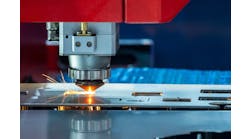I've heard and read many stories about how China has stolen our manufacturing, Michael Jordan's trademark and much more for that matter. Whether it's outright theft of intellectual property, roadblocks to return technology or even spying, you can be sure it is happening more places than we know. However, having seen this theft firsthand, I have also seen how American ingenuity has won this battle, so let’s forget about all these little battles and figure out how to win the war.
We, the United States, are in a manufacturing war; we just don't know it. In fact, I'm thinking this superpower got its butt kicked. Blame it on low-income nations taking a piece of the manufacturing pie or the slow recovery from the Great Recession. I blame a good percentage of it on China and its thieving ways. Throw in low labor rates, theft of intellectual property and equipment, and the playing field is tilted. I suppose all is fair in war.
One lost battle was noted by an excellent project engineer I know who told a story of a U.S. LCD manufacturer that moved to China to build a production facility, hoping to reduce costs. He helped to build the facility and machine control systems for the plant in China. As the plant was being built, he watched as a new facility was built directly across the street. One day, about eight months after the LCD manufacturer went into production, he showed up at the facility to find no workers were present. The workers had moved across the street to work for a Chinese manufacturer that had copied all the equipment and processes from the U.S. LCD manufacturer. It was a duplicate plant. Beware because, in China, your status in society increases if you manufacture something, no matter how you achieve that capability.
Also read: Why we should combine engineering with innovative methodologies
Another battle was lost when a U.S. startup manufacturer of "green" packaging products worked with a machine builder in China to develop a new manufacturing process. Once developed, the U.S. startup never received the equipment, but the Chinese manufacturer is now making and selling the product. I'm sure many of you have similar stories. Please tell.
And don't forget about the Chinese manufacturing spies. Otto Fest at Otek Intelligent Instruments has a story about how the Chinese specifically send interns or students to not only learn in the United States, but to steal trade secrets. In this case, the student was actually employed by a Chinese state-owned company in Beijing. At least the student didn't make it out the door with the flash drives that contained proprietary data. They took it out of his hand. He was fired immediately and fortunately this spy flunked out of college and went home.
The point is that China is probably stealing much more than you think. China is not only good at copying, but it is also stealing our IP and building plants around this theft at the expense of American companies and others. I have personally been called by a vendor asking me to email pictures, videos and drawings to China, so they could duplicate my equipment. I declined. I also never bought another robot from that company.
So, now that we know that this is happening, what should we do? Forget about the politics or hoping the U.S. government enacts protection. Let's just go ahead and be aware of the thieves and spies and improve the track record on our own through innovation and ingenuity. I want to push what I call the re-manufacturing of America. The approximate 20% of our GNP that manufacturing directly or indirectly affects is important.
Winning this manufacturing war starts with creative, high-speed, robust automatic machine designs. I know this works because I was recently involved with a project where a U.S. manufacturing plant beat out manufacturers in China, Japan and Thailand. They did it by partnering with an innovative custom machine builder who created a new modular, robotic assembly concept, detailed specifications and a modern, standardized design. The inventive design enabled a fast cycle rate.
This fast cycle rate trumped the low labor costs found in China and Thailand in this case. Not only that, but it reduced the menial manual-labor tasks that operators performed. Many of these operators were then trained to fill the high-tech jobs that were created to support the new equipment.
Run faster—the high-speed cycle rate is a great equalizer. The vision-guided robotics, vision inspection systems, precision motion control and clever test systems greatly increased cycle rate while reducing the labor rate. Network it all together, throw in some reusable PLCs, PACs and HMI software, get the production data, and world-class productivity is the result. Just remember to keep careful control of intellectual property and don't ship the cool equipment to China. That way, instead of a poor copy, it will be made in the USA.
Are you innovating?
Homepage image courtesy of kibsri at FreeDigitalPhotos.net






